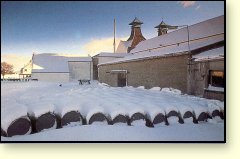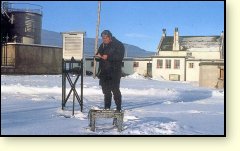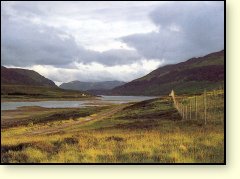
 |
|
Location: Dalwhinnie, Inverness-shire PH19 1AB
Hours: 9.30am - 5pm, Mon - Fri
Group bookings by appointment
Reception centre, shop and exhibition
Phone: (+44)01540- 672219
|
Text from The Whisky Trails, Copyright © Gordon Brown 1993:
In many ways Dalwhinnie is more like a fort guarding the Khyber Pass than a distillery on one of the country’s main roads. It is the highest distillery in Scotland, sitting at over a 1000 feet (350m) above sea level yet at the very bottom of an enormous exposed bowl of encircling mountains. In winter the wind scours the slopes unchecked and snow drifts so deeply that distillery workers have on occasion had to go to work leaving from the first-floor windows of their cottages.

Whatever the weather, it is the duty of the manager to take daily readings of pressure, temperature and rainfall for the Meteorological Institute.
|
The distillery is also an official meteorological station and the manager must take daily data from the Stevenson screen in the grounds no matter the weather. Sometimes it can be quite a fight. ‘Dalwhinnie’ means ‘meeting place’ and it was the junction of the main cattle droving routes from the north and west of the Highlands. Herds and herdsmen would rest here before tackling the final surge to the great cattle trysts in the Lowlands. Here too General Wade’s military road divided to follow similar directions and the line of the road actually runs through the grounds of the distillery. Many battles were fought in this very amphitheatre, the advantage of the home-fixture very much with the clansmen. Cromwell’s Ironsides were sent packing from here and Bonnie Prince Charlie and his men camped on the moors behind the distillery on the way south after his Standard was raised at Glenfinnan.
The distillery buildings are a visual pun, their black roofs and white walls referring to the Black & White blended whisky brand for which licensees, Buchanan’s, are well known. The original name was the Strathspey distillery, built this high at 1073 feet (327m) in 1898 to have the closest access to the uncontaminated, cold water of Lochan an Doire-uaine. Of course this was the worst possible time to be building a distillery and the company went into liquidation almost immediately. The name was changed to Dalwhinnie by the following owners and specialist distillery architect, Charles Doig of Elgin, was brought in to upgrade the buildings and layout. Dalwhinnie closed for several years after a serious fire in 1934, a time when there was still no electricity in the distillery or the village and paraffin lamps were still in use. Nor was there a telephone.
The distillery is surrounded by vast peat deposits, an important amenity in the early days, but its malt comes pre-peated from central maltsters now and has light-to-medium reek. Most of the storage capacities for raw materials are large making it possible for the distillery to produce for over a month if need be when it is snowed in. There is a single pair of stills and the original worm-tubs were from an old distillery at Kingussie.
The Whisky
Text from The Whisky Trails, Copyright © Gordon Brown 1993:
Dalwhinnie, in contrast to the wild and punishing country that yields it, is a soft and amenable malt. It is aromatic, shows delicately smoky peat and closes smoothly with some rich complexity. Dalwhinnie is officially 15 years old and 43% vol. but independents occasionally have vintages going back to 1970. The make goes into the Buchanan range of blends.
Source of water
Allt an t´Sluic Burn
Of interest
Text from The Whisky Trails, Copyright © Gordon Brown 1993:

Dalwhinnie is close by Loch Ericht, to the west of the Grampian Mountains.
|
• Dalwhinnie Hotel dates from 1729 and was a pretty basic inn when Queen Victoria visited in 1861 after a 13-hour journey. She took a dim view of the ‘two miserable, starved, Highland chickens’ that were served as her main course. Things have had plenty of time to improve by now. She had come close to buying an estate near here before finally deciding that Balmoral was the one she liked. If you stay overnight there may well be red deer in the garden when you look out of the window in the morning.
• Ruthven Barracks, windowless and gaunt on their natural platform in open country near Kingussie, were built by the government after the 1715 Rebellion and destroyed by the Highlanders after the failure of the 1745.
• The Highland Folk Museum at Kingussie is stuffed with data and artefacts about Highland life and history. It lays on exhibitions, both indoors and outdoors, and runs a programme of live demonstrations of country skills.
• Stag’s Breath whisky liqueur is produced at Newtonmore on the main road north towards Inverness. Tel: 01540-673733 for information about visits.